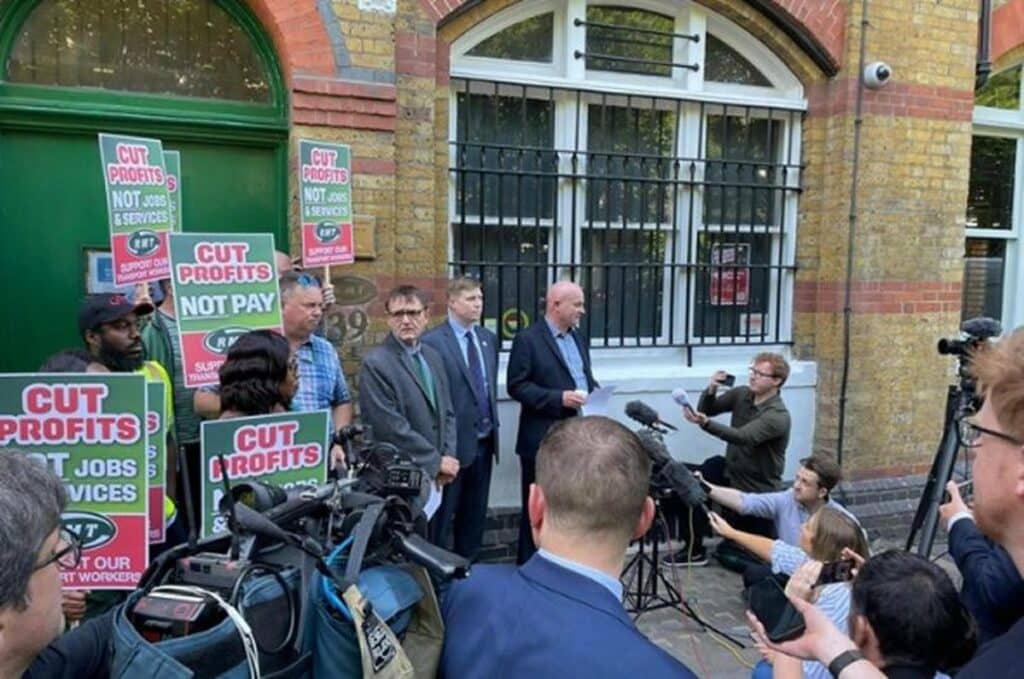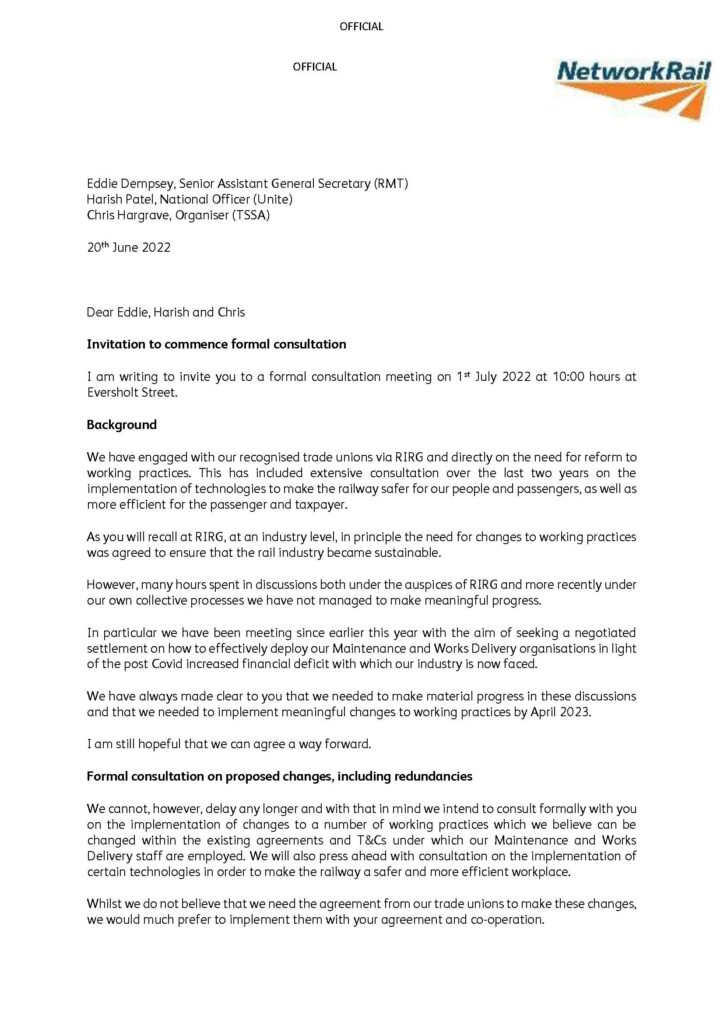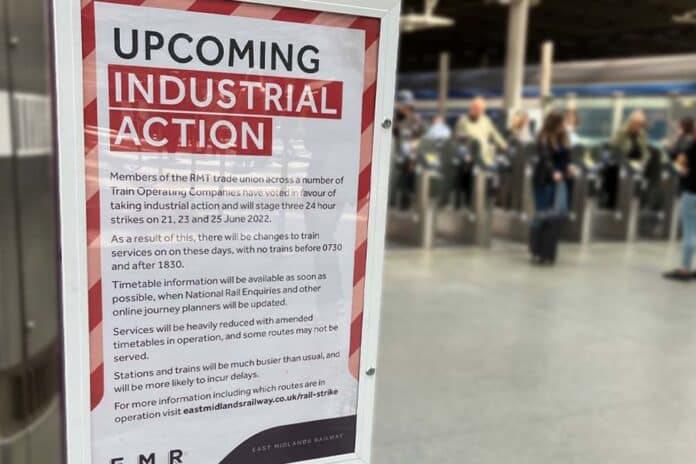On the eve of the national rail strike which started today (Tuesday 21 June 2022), Network Rail chief executive Andrew Haines spoke of his concerns and of the action taken so far to prevent industrial action.
Calling it “the most significant industrial action the railways have faced for 30 years,” he pointed out that the action that the National Union of Rail, Maritime and Transport Workers (RMT) is taking is against both Network Rail and the train operating companies (TOCs). He, of course, could only speak for Network Rail.
- A day of national strike action
- How services are affected by strikes
- National strike action begins today
Andrew Haines admitted he had been surprised by both the appetite for a strike shown by the RMT and for its suddenness. He and his team had been talking with the unions as part of the Rail Industry Recovery Group since December 2020, and early discussions had seemed promising. So, he felt that an understanding on a transition arrangement had been reached and was somewhat taken aback when the RMT executive seemingly overruled its own negotiators and confirmed the strike at short notice.
Network Rail front-line staff have historically had a wage increase every year, in January. They received one in January 2020 but missed January 2021, mainly due to the uncertainties around the COVID-19 pandemic. However, work continued during the lockdown, so most workers avoided being furloughed, receiving full pay when others around the country weren’t so lucky.

Andrew said that he hoped that ‘COVID Shock’ and the need to come back from low ridership, and therefore low fares income, would persuade people to talk openly about efficiencies and ending some of the “entrenched working practices” that worked against reducing cost. However, he said: “We’ve been able to demonstrate to the RMT that we are able to pay more than the public sector pay guidelines if there is genuine productivity agreed to, and we’ve made quite considerable progress on that. We appear to be right on the cusp, time and time again, of finalising agreement, and then it doesn’t quite come off.”
He put part of this down to a desire to avoid the “fudges” of the past, when productivity agreements were made to justify wage increases, and then the promised improvements were never delivered but also weren’t really chased by management. The result was a net cost increase to the industry. “I don’t blame the trade unions for that at all,” he said. “That’s good negotiation.
“But in today’s financial world, with passenger volumes what they are on Mondays and Fridays, that is not a path to a sustainable railway. And I think that’s the thing that we really, really struggled with.”
Network Rail unions were offered a two per cent increase, backdated to January 2022, and two further half-per-cent increases based on productivity improvements to commence October and November. That offer was rejected by the RMT last Friday (17 June).

So, Network Rail staff will be going on strike for three days, Tuesday, Thursday and Saturday of this week. To keep trains running, Network Rail has sufficient contingent signallers and ECROs (Electrical Control Room Operators) to run one 12-hour shift each day. With half an hour to open up and close down, that means trains can run for 11 hours on most routes.
These operators are drawn from Network Rail’s own staff – management, operators who have changed roles and others who have been trained up specifically to cover emergencies. They are not members of the RMT and have all been quizzed as to whether they will be prepared to cross picket lines, but only time will tell how that works.
It’s not a perfect solution. Some of them have day jobs that involve handling emergencies, so, if an incident should occur, they could have to leave their temporary posts to deal with it. And, of course, some may not actually cross picket lines if there is intimidation on the ground.
As to the trains that will run, in some circumstances freight will be given priority. Delivering biomass to Drax power station is one example, as is transporting aviation fuel to Heathrow, which doesn’t have nearly enough storage capacity to survive a lengthy rail strike. However, many construction companies and others have stockpiled materials in readiness for this week’s disruption.
Train frequencies will also be reduced, with Andrew Haines stating that it would be unfair for the contingent operators to be asked to run a full timetable on their first day back on the job.
Routine maintenance work has been cancelled for the week and, primarily, the weekend. As materials, labour and machinery has already been booked for that period, Andrew estimated the move could cost Network Rail £50 million, another expense when budgets are already strained.
Asked about the issue on railway pensions, Andrew Haines commented that this was a matter for the train operators. The Network Rail pension scheme was overhauled some years ago, with the support of the unions, and he doesn’t see that topic as an obstacle in getting Network Rail staff back to work. Nor does he see job cuts, which anyway haven’t been defined, as a problem – he felt that natural wastage and volunteers would be sufficient for Network Rail’s plans.
No, it’s all about pay and productivity – the age-old conflict between unions and management. How will it pan out this time?
A mismatch
In his briefing, Andrew Haines said on jobs: “We’ve given no compulsory redundancy to the vast majority of staff represented by the RMT.”
He went on to explain that there were around 1,800 jobs that could go out of the maintenance teams, from “tasks that don’t need doing”, but said that the overwhelming majority of those would be lost by voluntary severance.
Network Rail also said that, with retraining and redeployment available, it anticipates there will be a job for everyone that wants one.

However, later that very same day, Network Rail’s Paul Rutter, director of the Modernising Maintenance programme, issued a letter to representatives of RMT, Unite and TSSA. In it, he states: “We have been meeting since earlier this year with the aim of seeking a negotiated settlement on how to effectively deploy our Maintenance and Works Delivery organisations in light of the post Covid increased financial deficit with which our industry is now faced.
“We have always made clear to you that we needed to make material progress in these discussions and that we needed to implement meaningful changes to working practices by April 2023.”
He then invited the union representatives to attend a meeting to be held on 1 July 2022 to:
- commence formal consultation on Network Rail’s proposals to implement changes to working practices for all Maintenance and Works Delivery general grades; and
- as a result of those changes, to begin consultation on redundancies potentially arising as a result of the implementation of changes to working practices.
RMT general secretary Mick Lynch told the BBC: “Network Rail issued us formal notice of redundancies. For our members, that’s 2,900 people losing their jobs.”
So, there seems to be a mismatch between Network Rail’s figures and the trade unions’. Discussions continue, but meanwhile the country faces two more days of rail strikes on Thursday and Saturday 23 and 25 June.



































 0113 2082620
0113 2082620 info@railbusinessdaily.com
info@railbusinessdaily.com 15 Mariner Court, Wakefield WF4 3FL
15 Mariner Court, Wakefield WF4 3FL

